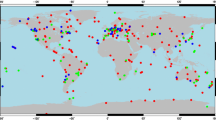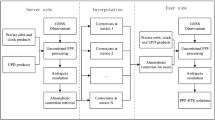Abstract
Precise point positioning (PPP) with ambiguity resolution can improve positioning accuracy and reliability. In conventional dual-frequency ionosphere-free (IF) PPP (IFPPP), the IF ambiguity loses its integer property, so the fixing process needs to be decomposed into a two-step way of fixing wide-lane (WL) and narrow-lane (NL) ambiguity separately. Only when both are fixed at the same time, can a reliable positioning solution be obtained. In order to take full advantages of multi-frequency signals and simplify the ambiguity resolution process, by proper selecting the combination coefficients, a PPP ambiguity resolution method based on ionosphere-reduced (IR) combination is proposed in this paper. The proposed IRPPP model hardly needs to consider the effect of ionosphere, while has the equivalent wavelength and observation noise compared with conventional IFPPP. In addition, the combined IR ambiguity maintains its integer solvability, thus only one-step of directly fixing the IR ambiguity is need to achieve positioning performance comparable to conventional IFPPP. The model is further evaluated globally, and the results show that the IRPPP is superior to the conventional IFPPP in terms of the number of available NL ambiguity and the time to first fix (TTFF), and the average TTFF can be shortened by 22.6%. As for positioning accuracy, both models are basically the same with centimeter-level accuracy.
Access this chapter
Tax calculation will be finalised at checkout
Purchases are for personal use only
Similar content being viewed by others
References
Zumberge JF, Heflin MB, Jefferson DC et al (1997) Precise point positioning for the efficient and robust analysis of GPS data from large networks. J Geophys Res: Solid Earth 102(B3):5005–5017
Kouba J, Héroux P (2001) Precise point positioning using IGS orbit and clock products. GPS Solut 5(2):12–28
Ge M, Gendt G, Rothacher M et al (2008) Resolution of GPS carrier-phase ambiguities in precise point positioning (PPP) with daily observations. J Geodesy 82(7):389–399
Gabor MJ, Nerem RS (1999) GPS carrier phase ambiguity resolution using satellite-satellite single differences[C]. In: Proceedings of the 12th international technical meeting of the satellite division of the institute of navigation (ION GPS 1999). 1999, pp 1569–1578
Laurichesse D, Mercier F, Berthias JP et al (2009) Integer ambiguity resolution on undifferenced GPS phase measurements and its application to PPP and satellite precise orbit determination. Navigation 56(2):135–149
Collins P, Lahaye F, Heroux P et al (2008) Precise point positioning with ambiguity resolution using the decoupled clock model. In: Proceedings of the 21st international technical meeting of the satellite division of the institute of navigation (ION GNSS 2008), pp 1315–1322
Li P, Zhang X, Ren X et al (2016) Generating GPS satellite fractional cycle bias for ambiguity-fixed precise point positioning. GPS Solut 20(4):771–782
Geng J, Meng X, Dodson AH et al (2010) Integer ambiguity resolution in precise point positioning: method comparison. J Geodesy 84(9):569–581
Shi J, Gao Y (2014) A comparison of three PPP integer ambiguity resolution methods. GPS Solut 18(4):519–528
Laurichesse D, Banville S (2018) Innovation: instantaneous centimeter-level multi-frequency precise point positioning. In: GPS World 4 July 2018
Geng J, Bock Y (2013) Triple-frequency GPS precise point positioning with rapid ambiguity resolution. J Geodesy 87(5):449–460
Li X, Li X, Liu G et al (2019) Triple-frequency PPP ambiguity resolution with multi-constellation GNSS: BDS and Galileo. J Geodesy 93(8):1105–1122
Li X, Liu G, Li X et al (2020) Galileo PPP rapid ambiguity resolution with five-frequency observations. GPS Solut 24(1):1–13
Guo J, **n S (2019) Toward single-epoch 10-centimeter precise point positioning using Galileo E1/E5a and E6 signals. In: Proceedings of the 32nd international technical meeting of the satellite division of the institute of navigation (ION GNSS+ 2019), pp 2870–2887
Gu S, Lou Y, Shi C et al (2015) BeiDou phase bias estimation and its application in precise point positioning with triple-frequency observable. J Geodesy 89(10):979–992
Li P, Zhang X, Ge M et al (2018) Three-frequency BDS precise point positioning ambiguity resolution based on raw observables. J Geodesy 92(12):1357–1369
Geng J, Guo J, Meng X et al (2020) Speeding up PPP ambiguity resolution using triple-frequency GPS/BeiDou/Galileo/QZSS data. J Geodesy 94(1):1–15
Zhao Q, Pan S, Gao W et al (2022) Multi-GNSS fast precise point positioning with multi-frequency uncombined model and cascading ambiguity resolution. Math Probl Eng
Geng J, Guo J, Chang H et al (2019) Toward global instantaneous decimeter-level positioning using tightly coupled multi-constellation and multi-frequency GNSS. J Geodesy 93(7):977–991
Geng J, Guo J (2020) Beyond three frequencies: an extendable model for single-epoch decimeter-level point positioning by exploiting Galileo and BeiDou-3 signals. J Geodesy 94(1):1–15
Elsobeiey M (2015) Precise point positioning using triple-frequency GPS measurements. J Navig 68(3):480–492
Duong V, Harima K, Choy S et al (2019) An optimal linear combination model to accelerate PPP convergence using multi-frequency multi-GNSS measurements. GPS Solut 23(2):1–15
Melbourne WG (1985) The case for ranging in GPS-based geodetic systems. In: Proceedings of the first international symposium on precise positioning with the global positioning system, 1985, Rockville, MD, USA, 15–19 April 1985, pp 373–386
Temiissen JG (1995) The least-squares ambiguity decorrelation adjustment: a method for fast GPS integer ambiguity estimation. J Geodesy 70:65–82
Yang Y, Gao W, Guo S et al (2019) Introduction to BeiDou-3 navigation satellite system. Navigation 66(1):7–18
Feng Y (2008) GNSS three carrier ambiguity resolution using ionosphere-reduced virtual signals. J Geodesy 82(12):847–862
Guo F, Zhang X, Wang J et al (2016) Modeling and assessment of triple-frequency BDS precise point positioning. J Geodesy 90(11):1223–1235
Gao W, Gao C, Pan S (2017) A method of GPS/BDS/GLONASS combined RTK positioning for middle-long baseline with partial ambiguity resolution. Surv Rev 49(354):212–220
Acknowledgments
This work is partially supported by the National Natural Science Foundation of China (Grant No. 42204027), and the Foundation of Laboratory of Science and Technology on Marine Navigation and Control, China State Shipbuilding Corporation (Grant No. 2021010104). The authors sincerely thank IGS and CODE for providing multi-GNSS data and products.
Author information
Authors and Affiliations
Corresponding author
Editor information
Editors and Affiliations
Rights and permissions
Copyright information
© 2024 Aerospace Information Research Institute
About this paper
Cite this paper
Zhao, Q., Pan, S., Gao, W., Liu, J., Lu, Y., Zhang, P. (2024). Precise Point Positioning Ambiguity Resolution with Multi-frequency Ionosphere-Reduced Combination. In: Yang, C., **e, J. (eds) China Satellite Navigation Conference (CSNC 2024) Proceedings. CSNC 2024. Lecture Notes in Electrical Engineering, vol 1094. Springer, Singapore. https://doi.org/10.1007/978-981-99-6944-9_20
Download citation
DOI: https://doi.org/10.1007/978-981-99-6944-9_20
Published:
Publisher Name: Springer, Singapore
Print ISBN: 978-981-99-6943-2
Online ISBN: 978-981-99-6944-9
eBook Packages: EngineeringEngineering (R0)




